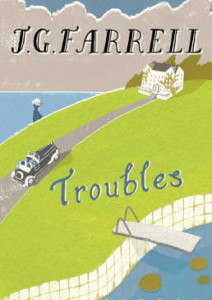Set in 1919-21, years of conflict when the struggle for Irish independence raged, Troubles is the first in J.G. Farrell’s 1970’s trilogy of historical novels dealing with the decline of empire. Troubles follows the fortunes of Major Brendan Archer who, traumaticised and lacking purpose after serving in the First World War, crosses the Irish Sea to the fictional town of Kilnalough to meet with his fiancé, Angela Spencer, to whom he’d almost unwittingly become engaged following a brief, scarcely remembered, meeting three years previously.
Archer, known to all as ‘the Major’, finds himself in the Majestic, a 300-room hotel owned by the upper-class Protestant Spencer family. It becomes apparent that this crumbling edifice, in which the rot has literally set in, functions as an allegory for the whole Imperial enterprise. As a staunch loyalist and Unionist, the hotel’s owner Edward Spencer sees himself as an upholder of a version of the white man’s burden, and aggressively seeks to defend an Anglo-Irish way of life already doomed by history. Consequently any attempts to carry on business as usual, isolated from the upheaval in the surrounding towns and countryside prove to be futile. The Major quickly becomes embroiled in the petty domestic squabbles and territorial rivalries, (echoing in comic form the tragic disturbances in the country as a whole), among the staff and human and non-human patrons of the Majestic. While readers experience events from the point of view of the Major, he is at best an unreliable narrator, deeply implicated in the chaos that unfolds. Unsure of his own role and direction in life, he treads a thin line between decorum and riot; a line that inevitably becomes a tripwire. It is said of Angela’s twin sisters, two girls coming of age and out for a good time, ‘with the twins everything has a habit of beginning amusingly and ending painfully’, in many ways an appropriate synopsis of events in the Majestic as a whole. Ironically called Faith and Charity , the twins wouldn’t be out of place as modern stand-ins for Cora and Clarice in Gormenghast, Mervyn Peake’s comparable bastion of cruelty, intrigue and farce.
Troubles was published in 1970 and so had obvious resonances with the later war in Northern Ireland at time when the ‘Troubles’ were in their most intense phase. There is a self-perpetuating cycle of atrocity and reprisals between the IRA and the Black and Tans, a conflict Ken Loach more recently portrayed in his 2006 film The Wind that Shakes the Barley. Troubles, and Farrell’s other great tragi-comic novel The Siege of Krishnapur, explores and parodies historic events. It critiques the colonial project at one remove, while providing a lively panorama of the entire spectrum of characters depicting class, generations, gender, religious divides, professions and nuances of opinion. If you enjoy historical fiction I would heartily recommend a sojourn at the Majestic. Nearly 45 years after its publication, Troubles is a novel that should not be overlooked.
Steve 14/2/2014





